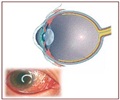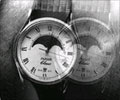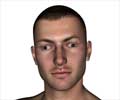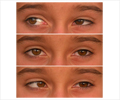- American Academy of Ophthalmology Basic and Clinic Science Course (BCSC series) Section 6- Pediatric Ophthalmology and Strabismus
- Kanski J. Clinical Ophthalmology. A systematic approach
What is Strabismus?
Strabismus or squint is a failure of the two eyes to maintain proper alignment. Proper evaluation and timely intervention are necessary to prevent permanent forms of visual dysfunction such as diminished depth perception and lazy eye.
Why does Strabismus occur?
The position of each eyeball is maintained by six extraocular muscles. These muscles get their innervation from the 3rd, 4th and 6th cranial nerves (nerves that originate in the brain). These muscles move the eyes in various directions. Any weakness in movements either due to central mechanisms or due to direct involvement of the nerves or the mechanical restriction of eye movements can result in strabismus.
Basics of Squint and Binocular Vision
Proper ocular alignment is necessary for –
- Proper visual stimulation
- Prevention of amblyopia (lazy eye)
- Binocular single vision (the ability to perceive objects seen by both the eyes as one, along with depth perception)
- Cosmesis
Visual stimulation is very crucial in children for proper functional development of the visual system. Any barrier to an appropriate visual stimulus (either in the form of an obstruction such as cataract or an ocular deviation such as squint) can result in the formation of a lazy eye (amblyopia), in which stimulation does not result in a good image, and hence renders vision in that eye subnormal. The younger the child, the greater the chances of and the depth of amblyopia.
Binocular vision has 3 grades -
- Simultaneous macular perception (the images of objects in both eyes are appreciated by the person)
- Fusion (separate images arising in each eye are appreciated as a single image)
- Stereopsis (depth perception) - this is the highest grade of binocular vision, and which provides us with exceptional skill for certain tasks.
When there is a squint, one or more of these are affected to varying degrees, depending on the degree of squint, duration of squint, age at which squint develops and depending on whether it is an intermittent or a constant squint.
What are the Different Types and Causes of Strabismus?
Strabismus can be either latent or manifest. In latent squint,the tendency to squint is present, but kept in check by the fusion mechanisms of the eyes. Whenever fusion is interrupted, or when it is weak either due to illness or fatigue, the squint becomes manifest or apparent.
Manifest squint
Manifest squint is of two types -
- Comitant (degree of deviation constant in all directions of gaze and no limitation of eye movements)
- Incomitant (deviation varies in different directions of gaze with limitation of eye movements)
Comitant squint
This is the most common type of squint that is present in children. It may either be a convergent squint (esotropia) or divergent squint (exotropia). Persons with comitant squint do not experience double vision.
Some of the risk factors for comitant squint are prematurity, central nervous system impairment, low birth weight, family history of squint (usually same type is present), and refractive error. Exotropia or divergent squint is more common in Asia, in contrast to convergent squint or inward deviation of the eyes (esotropia) which is more common in the west.
Convergent squint may present within the first few months or years of life. When it presents at around the pre-school age, it could be related to the use of accommodation (increased focusing power of the eye for near) either with or without associated hypermetropia (farsightedness). Overcorrection of a divergent squint or conditions that interfere with proper vision in younger children (such as drooping of the eyelid to obstruct vision, cataract, retinoblastoma or large refractive errors) can also cause convergent squint.
Divergent squint may be present at birth or later on when it is present intermittently initially, and later on becomes constant. Overcorrection of a convergent squint or long standing visual deprivation in one eye in adults (eg. cataract, corneal opacitiers, retinal problems) can also cause a divergent squint.
Incomitant squint
In incomitant squints, there is a limitation of movement of the muscles moving the eye, resulting in double vision.
- Paralytic squint – due to a weakness in the muscles moving the eyes or the nerves supplying them eg. myasthenia gravis, nerve paralysis.
- Restrictive squint – due to a physical restriction on the movement of the muscles eg. thyroid eye disease, tumors in the orbit.
What are the Signs and Symptoms of Strabismus?
- Decreased vision, either due to refractive error, disorder in the eye, or due to suppression
- Outward or inward deviation of the eyes
- Reduced binocular function
- Double vision if there is intermittent squint
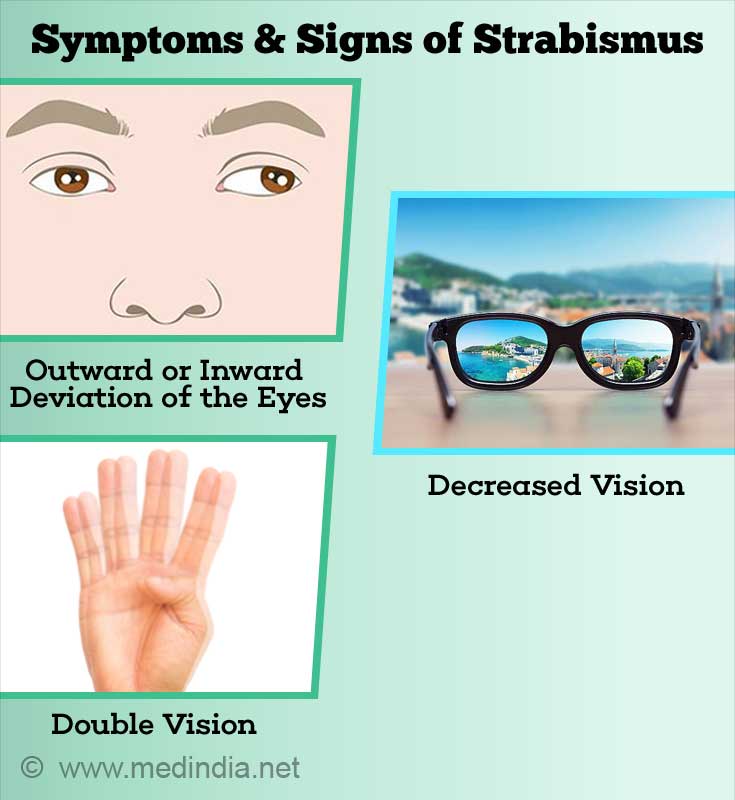
What are the Consequences of Untreated Squint?
- Suppression of image in the deviating eye to prevent double vision. Thus the higher degrees of binocular vision are affected.
- Abnormal retinal correspondence -
- A poor adaptation made by the sensory mechanisms to maintain some sort of binocular vision even in the presence of a squint.
- This should be specifically looked for in every patient of squint prior to surgical correction. If present, this should be addressed, otherwise surgical correction of the squint can lead to double vision.
How do you Diagnose Squint?
The outward or inward deviation is obvious and patient presents mainly with this symptom.
How do You Evaluate a Person with Squint?
- Visual acuity measurement- Visual acuity is usually abnormal. It may be normal if it is an intermittent or a squint alternating between the two eyes. Diminished vision may either be due to a refractive error, pathology such as cataract or retinal disorders, suppression, or a combination of these factors. Visual acuity measurement in younger children is more challenging. There are special charts and devices for this purpose and it requires a great deal of patience.
- Cycloplegic refraction:It is an objective determination of the true refractive error, by elimination of the effect of accommodation. This is achieved by paralyzing the ciliary muscle with cyclopentolate eye drops or atropine eye ointment. These drugs also cause dilatation of the pupil making it easier for the doctor to examine the retina.
- Slit lamp exam-This test checks for any diseases or abnormalities in the anterior portion of the eye
- Fundus (retina) examination-It is also referred to as fundoscopy, and is used to view the eye's interior portion, involving assessment of the retina, optic nerve and blood vessels
- Measurement and quantification of the amount of deviation
- Assessment of movement of the eyes in various directions of gaze
- Assessment of double vision if present
- Determination of the degree of binocular vision that is present
- Paralytic and restrictive squints may require additional testing for certain diseases such as CT scanning of orbits and brain or lab testing for thyroid hormone levels
How do you Treat Squint?
Concomitant squint can be managed both by non-surgical and surgical treatments depending upon the condition of patient.
Non-surgical methods
- Correction of refractive error- Refractive errors like myopia, astigmatism, and high degrees of hypermetropia need to be corrected both for improvement of vision as well as to help in reducing the stimulus for squint.
- Orthoptic treatment makes use of fusional training exercises and may be useful in some cases.

- Occlusion: Occlusion of one eye (the non-deviating eye) is required in children who have amblyopia due to the deviation (to stimulate vision in the deviating eye).
- Prism therapy- Prisms incorporated into spectacles are extremely helpful in improving the appearance of the eyes and facilitating the patient’s communication and interaction with others. It alleviates difficulties associated with misalignment. It is useful for older patients with limited fusional capabilities.
Surgical correction
- Surgery is generally considered only after unsatisfactory non-surgical approaches. The goals of surgery are restoration of alignment and binocular function.
Incomitant squint needs correction of the underlying cause. Any residual squint may need to be corrected by surgery.
How do you Prevent Squint?
Squint may be prevented in certain cases -
- Detection of squint when it is still latent and application of corrective measures for the underlying cause
- Prompt correction of refractive errors
- Correction of conditions that obstruct vision






